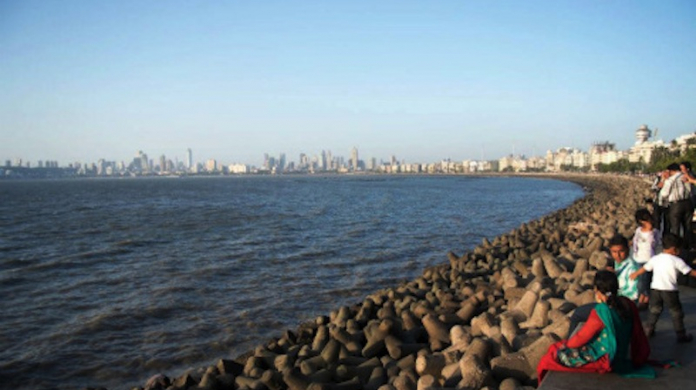MUMBAI
On arrival in Mumbai the gorgeous heat, clamourous cacophony of car horns and dust were all completely overwhelming. I have since been reading Katherine Boo’s Behind the Beautiful Forevers and can appreciate, having glimpsed from the plane window the famous sprawling slums next to the airport, the description of that road as "Where Old India and New India collide, making New India late".
Sunil Shanbag, our first meeting, was responsible for the Gujarati All's Well That Ends Well at the Globe to Globe Festival, and he and Sudha share a love of work derived from well-crafted text. He was extremely familiar with the work of Tamasha and, for me, was an introduction to the passion, tenacity and energy it takes to be part of the theatre world in India: no subsidy, super-long hours, eight hour turn-arounds and get in-perform-get out-drive-home. Sudha observed on our ride home the next day that we had already heard some amazing nuggets for a verbatim piece A Postcard from Bombay, an insight into the growing 'squeezed’ middle class of India.
We visited the buzzing 200-seat Prithvi Theatre in Juhu the next day. Kunal Kapoor has recently taken over the running of this family business where they stage shows in both Hindi and English (as well as other languages on occasion). With a programme of new writing, contemporary theatre, music and other cultural activities, and a gorgeous outside area, the theatre has a festival vibe and lots of potential for a Tamasha visit. We could see our forthcoming show My Name Is…, written by Sudha, working really well there…
After this, we met Quasar Padamsee, a theatre director and producer. Quasar is extremely prolific, has recently worked as Tim Supple's Assistant Director on the international tour of A Midsummer Night’s Dream, and has a number of exciting projects on the go. He mentioned the huge growth in English-language theatre in India, and typified the type of boundless energy and commitment we had already witnessed.
That night we were taken for dinner by the magnificent Ila Arun, who played the title role in our 2010 production The House of Bilquis Bibi, and writer/producer K.K Raina. Many a potential creative collaboration was discussed - from Indian remounts of certain popular Tamasha shows to new ideas. Following a boat trip and a drink in the world famous Taj Mahal Palace Hotel (it had to be done!) we met Deepa Ghalot at the National Centre for Performing Arts (NCPA) where Tamasha had performed 20 years ago. NCPA does a number of exciting international collaborations and Deepa’s reception to a number of our ideas was very warm. We discovered that because the Mumbai traffic is so thick productions often tour to both Prithvi and NCPA, as they are at opposite ends of the city.
Our next meeting was with Shernaz Patel of the wonderful new writing theatre, Rage Theatre. During a meaty discussion (Tamasha and Rage share many aims and passions) we talked of creative exchanges for artists of British Asian origin to India, ways that Rage can contribute to and involve their writers in our Scratch Nights, and a lot about verbatim theatre.
BANGALORE
We embarked on a whirlwind trip to ‘Software City’ Bangalore, arriving at night, packing in two meetings in different parts of town the next day and flying out to Delhi the following morning. I am in love with the Kannada language script daubed on walls around the city, as well as the chunky architecture and different kind of greenery here. We met Jagdish and Arundati Raja, as well as their son and colleagues at Jagriti Theatre. Jagriti is a beautiful 200-seat auditorium built around a full thrust stage, with a vision to professionalise English-language theatre in India. This space is the recent realisation of a dream 30 years in the making. Jagriti supports its performers and has a strong training and education arm. Again, it’s hard not to see a Tamasha show making perfect sense here. On to another part of town to the Rangashankara Theatre, a lovely 320-seat, eight-year-old theatre which does a lot of Shakespeare, international collaborations and Hindi/English work, as well as hosting an annual children’s theatre festival.
DELHI
In Delhi we met with Shaguna Gahilote from the British Council, who supported our trip through their recent Connections through Culture scheme. After this we went on over to meet Abhilash Pillai at the National School of Drama, Tamasha’s birthplace, where Kristine first directed Untouchable in 1989! They were keen for collaboration on a number of levels and especially interested in Tamasha’s intra-cultural approach. I was struck by the fact that they offer a stage management course where apparently students from the West often come to unlearn what they know about stage management! The next day we met with Renu Oberoi of the Habitat Centre, an ingenious space which is home to a number of environmentally conscious organisations, an indoor amphitheatre and small outdoor performance space. That night we went to Twelfth Night in Hindi and English by upcoming writer/director Neel Chowdary at pop-up outdoor venue Zorba the Budha. The show was stunning. On our last night in Delhi we visited the Kamani Auditorium to see Gasha, a new play about Kashmir directed by Abhishek Majumdar who has recently been commissioned by the Royal Court. I could tell that it was well acted, interestingly staged, and balanced humour and sadness, but I couldn’t understand a word (it was in Hindi/Kashmiri/Urdu) so you would have to ask Sudha about it in detail!
And so we returned to London. Adventures had, insights gained and some amazing people met.
